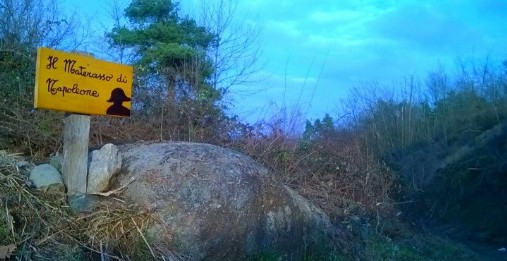CURIOSITA'


CURIOSITA'

Faraone Europeo
Napoleone Bonaparte è seppellito alla base della cupola degli Invalidi sotto un pavimento di porfido rosso proveniente dalla Russia su cui campeggiano ben sette sarcofagi di diversi materiali, né più né meno come un faraone dell'Occidente.
Napoleon Bonaparte is buried at the base of the dome of the Invalids under a red porphyry floor from Russia on which seven sarcophagi of different materials stand out, neither more nor less like a pharaoh of the West.

FBI
Nel 1908 il nipote di Napoleone, Carlo Bonaparte, ha creato l’FBI negli Stati Uniti.
In 1908 Charles Bonaparte, Napoleon’s nephew, founded the FBI in the United States.
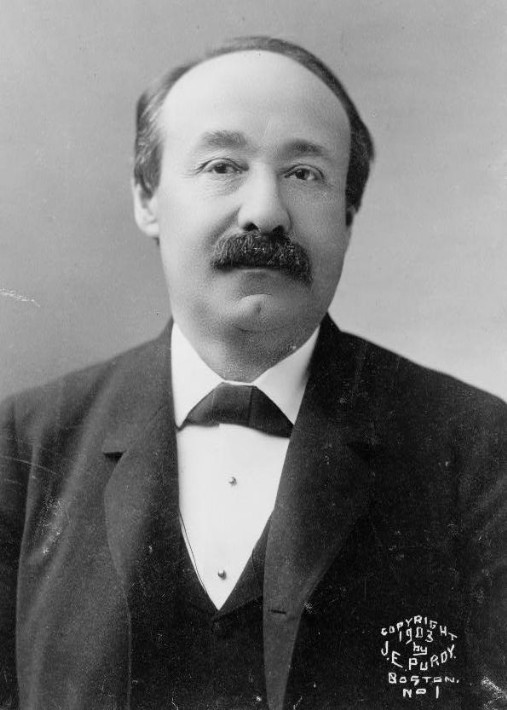

Gatti Neri
Temerario (e superstizioso). E non è vero che avesse la fobia dei gatti. Lo ha precisato la storica Katharine MacDonogh nel libro "Storia dei cani e gatti a corte dai tempi del rinascimento", dopo averlo letto da più parti: non esiste alcuna evidenza storica che Napoleone soffrisse di ailurofobia. Ma era superstizioso e come molti europei del tempo si teneva lontano i gatti neri.
Bold (and superstitious). And it is not true that he had the phobia of cats. This was stated by the historian Katharine MacDonogh in the book "History of court dogs and cats from the time of the Renaissance", after having read it from many sides: there is no historical evidence that Napoleon suffered from ailurophobia. But he was superstitious and like many Europeans of the time black cats were kept away.

Genio Militare
Nessun comandante militare ha vinto più battaglie di Napoleone I.
Per compiere queste prodezze, l'Imperatore si avvale della coscrizione messa in atto sotto la Rivoluzione. Istituisce anche degli eserciti che sono durati fino ai giorni nostri e introduce un comando centralizzato molto efficiente.
A livello strategico, Napoleone comprende la necessità di rompere l'equilibrio delle forze nemiche, cercando sempre di colpire l'avversario al cuore o aggirarlo tagliando le vie di comunicazione e impedendone la ritirata.
No military commander has won more battles than Napoleon I.
To accomplish these feats, the Emperor avails himself of the conscription put in place under the Revolution. It also establishes armies that have lasted to the present day and introduces a very efficient centralized command.
At a strategic level, Napoleon understands the need to break the balance of enemy forces, always trying to hit the opponent in the heart or circumvent it by cutting off communication routes and preventing them from retreating.
To accomplish these feats, the Emperor avails himself of the conscription put in place under the Revolution. It also establishes armies that have lasted to the present day and introduces a very efficient centralized command.
At a strategic level, Napoleon understands the need to break the balance of enemy forces, always trying to hit the opponent in the heart or circumvent it by cutting off communication routes and preventing them from retreating.

Gesù
Su Internet, è il personaggio storico più citato dopo Gesù.
On the internet, Napoleon is the most quoted historical figure after Jesus.

Gioconda
Rubò la Gioconda? Non è neppure vero che trafugò la Gioconda di Leonardo: secondo gli storici il dipinto si trovava in Francia dal 1517, dove lo aveva portato proprio l'autore. In seguito il quadro fu acquistato molto probabilmente dal Re Francesco I: Napoleone, grande appassionato d'arte nel 1800 si limitò ad appenderlo nelle stanze della moglie Josephine e in seguito la Monna Lisa entrò a far parte della collezione permanente del Louvre (che all'epoca si chiamava Museo Napoleone). La bufala del furto napoleonico nasce forse dal fatto che i soldati napoleonici trafugarono davvero alcune opere d'arte durante la campagna d'Italia. Ma non la Gioconda.
Did he steal the Mona Lisa? Nor is it true that he stole Leonardo's Gioconda: according to historians, the painting had been in France since 1517, where the author had brought it. Later the painting was probably purchased by King Francis I: Napoleon, a great art lover in the 1800s, simply hung it in his wife Josephine's rooms and later the Mona Lisa became part of the permanent collection of the Louvre (which era called Napoleon Museum). The hoax of Napoleonic theft probably derives from the fact that the Napoleonic soldiers really stole some works of art during the Italian campaign. But not the Mona Lisa.

Grande Armée
Napoleone utilizza per la prima volta il termine "la Grande armata" il 29 Agosto 1805, quando lascia il campo di Boulogne per andare a combattere ad Austerlitz. Rapidamente, il "Bulletin de la Grande Armée" diffonde il termine esaltando le prodezze militari.
I grognard (soldati della Guardia Imperiale di Napoleone), i generali e alcune figure femminili contribuiscono a far emergere i soldati dall'anonimato.
I soldatini di carta e poi in Piombo realizzati a Epinal o a Strasburgo, avvicinano i francesi alla loro storia.
Napoleon used the term "the Great Army" for the first time on August 29, 1805, when he left the Boulogne camp to go to fight in Austerlitz. Quickly, the "Bulletin de la Grande Armée" spreads the term highlighting the military prowess.
The grognards (soldiers of Napoleon's Imperial Guard), generals and some female figures help bring soldiers out of anonymity.
The paper and then Lead soldiers made in Epinal or Strasbourg bring the French closer to their history.
The grognards (soldiers of Napoleon's Imperial Guard), generals and some female figures help bring soldiers out of anonymity.
The paper and then Lead soldiers made in Epinal or Strasbourg bring the French closer to their history.

Guanti bianchi di Napoleone
La biblioteca ambrosiana di Milano conserva i guanti bianchi che Napoleone utilizzò durante la battaglia di Waterloo.
The Ambrosian library in Milan preserves the white gloves that Napoleon used during the battle of Waterloo.
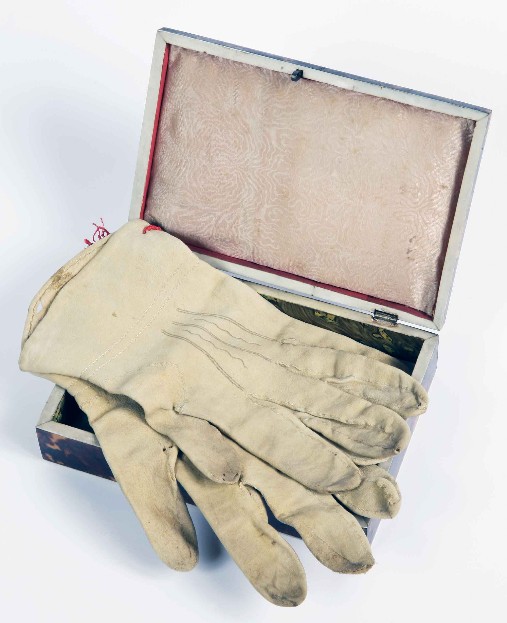

Guardia Imperiale
Per essere ammessi nella Guardia Imperiale, l'élite dell'élite, bisogna avere almeno cinque anni di servizio, essere stato segnalato per degli atti di coraggio e una condotta impeccabile. Questi guerrieri formidabili sono fermamente attaccati al loro Imperatore.
To be admitted to the Imperial Guard, the elite of the elite, one must have at least five years of service, to have been reported for acts of courage and impeccable conduct. These formidable warriors are firmly attached to their Emperor.
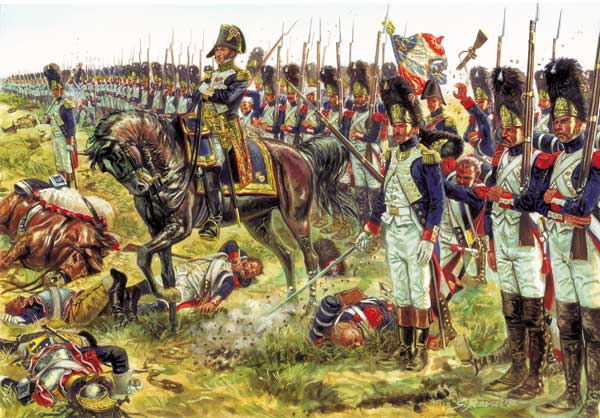

Il cane di Joséphine de Beauharnais
Joséphine (1763 - 1814), prima moglie di Napoleone Bonaparte, aveva un carlino chiamato Fortuna, che veniva da lei usato per mandare a Napoleone messaggi privati. Si dice che nella prima notte di nozze Napoleone si fosse rifiutato di permettere a Fortuna di dormire nel letto con loro e Fortuna lo avesse morso. Joséphine avrebbe allora detto: "Se il carlino non dorme nel nostro letto, neanch'io!". Da allora Napoleone condivise il suo letto con Joséphine e il suo carlino.
Joséphine (1763 - 1814), Napoleon Bonaparte's first wife, had a pug called Fortuna, which she used to send private messages to Napoleon. It is said that on the first wedding night Napoleon refused to allow Fortuna to sleep in bed with them and Fortuna had bitten him. Josephine would then have said: "If the pug does not sleep in our bed, neither will I." Since then Napoleon shared his bed with Joséphine and his pug.

Incoronazione
Bonaparte fu anzitutto un grande comunicatore. E proprio pe questo pretese che la sua salita al trono imperiale, avvenuta il 2 dicembre 1804, fosse ricordata con un grande con un grande dipinto. Per realizzarlo scelse l'affermato pittore Jacques-Louis David (1748-1825), che eseguì questo disegno preparatorio, ma non vi ritrasse Maria Letizia Romolino, l'amata madre del conquistatore, e disegnò l'imperatore che si incoronava da solo, come di fatto era avvenuto nella cattedrale di Notre-Dame. Napoleone infatti chiese al Papa di incoronarlo, ma nel momento cruciale si incoronò da solo: solo Napoleone poteva incoronare Napoleone! (altre teorie dicono che il Papa fosse a conoscenza delle sue decisioni).
Quando vide la bozza del quadro, N. chiese ed ottenne due importanti correzioni. Così nell'opera definitiva sua madre è addirittura al centro del quadro, e lui è dipinto nel momento in cui incorona la moglie Josephine di Beauharnais, con un gesto che gli conferisce un'immagine meno autoritaria e più nobile. Anche in questo caso, la rappresentazione della realtà era plasmata dalla strategia politica.
Bonaparte was above all a great communicator. And precisely for this reason he claims that his ascent to the imperial throne, which took place on December 2, 1804, was remembered with a large one with a large painting. To achieve this, he chose the established painter Jacques-Louis David (1748-1825), who executed this preparatory drawing, but did not portray Maria Letizia Romolino, the beloved mother of the conqueror, and designed the emperor who crowned himself, as in fact it had happened in the cathedral of Notre-Dame. Napoleon in fact asked the Pope to crown him, but at the crucial moment he crowned himself: only Napoleon could crown Napoleon!
When he saw the draft of the painting, N. asked and obtained two important corrections. Thus in the definitive work his mother is even at the center of the picture, and he is painted at the moment when he crowns his wife Josephine of Beauharnais, with a gesture that gives him a less authoritarian and nobler image. Also in this case, the representation of reality was shaped by political strategy.
When he saw the draft of the painting, N. asked and obtained two important corrections. Thus in the definitive work his mother is even at the center of the picture, and he is painted at the moment when he crowns his wife Josephine of Beauharnais, with a gesture that gives him a less authoritarian and nobler image. Also in this case, the representation of reality was shaped by political strategy.
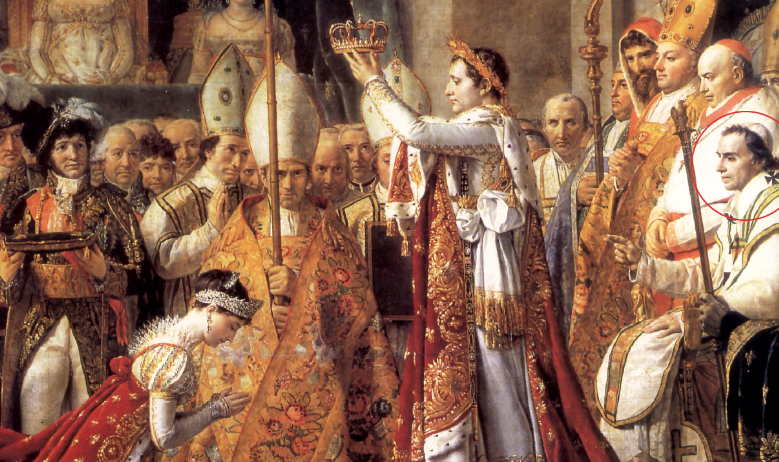

Inno Polacco
Il nome di Napoleone è citato nell’inno polacco.
Napoleon’s name is quoted in the Polish anthem.

Infanzia
Nato il 15 agosto 1796 ad Ajaccio, Napoleone Bonaparte trascorre un'infanzia rigida e turbolenta in Corsica.
Figlio di Charles-Marie Bonaparte e di Letizia Ramolino, ferventi esponenti della resistenza all'annessione francese.
Napoleone conosce maglio la linga italiana che quella francese.
La famigla acquisisce il titolo di nobiltà nel 1771. Nel 1778 Charles Marie riceve delle borse di studio per i suoi figli.
Napoleone e il fratello maggiore Joseph entrano così al Collegio di Autun nel gennaio del 1779. Napoleone studia il francese e inizia la scuola militare di Brienne nel maggio 1779 dove resterà fino al 1784.
Born August 15, 1796 in Ajaccio, Napoleon Bonaparte spent a rigid and turbulent childhood in Corsica.
Son of Charles-Marie Bonaparte and Letizia Ramolino, fervent exponents of the resistance to the French annexation.
Napoleon knows the Italian lingo from the French language.
The family acquired the title of nobility in 1771. In 1778 Charles Marie received scholarships for her children.
Napoleon and his elder brother Joseph then entered the College of Autun in January 1779. Napoleon studied French and began the military school of Brienne in May 1779 where he remained until 1784.
Son of Charles-Marie Bonaparte and Letizia Ramolino, fervent exponents of the resistance to the French annexation.
Napoleon knows the Italian lingo from the French language.
The family acquired the title of nobility in 1771. In 1778 Charles Marie received scholarships for her children.
Napoleon and his elder brother Joseph then entered the College of Autun in January 1779. Napoleon studied French and began the military school of Brienne in May 1779 where he remained until 1784.

Italiano
I Buonaparte vantavano nobili origini toscane, anche se si erano trasferiti in Corsica, allora genovese, già nel 1567. Lo stesso Napoleone confessò: “Io sono italiano o toscano, piuttosto che còrso”. Questa frase però non deve trarre in inganno. Raccontava di essere italiano, ma dell’Italia diceva peste e corna: come ogni politico badava al sodo, a quello che poteva tornargli utile. La familiarità linguistica (in Corsica l’italiano era lingua ufficiale) gli rendeva congeniale l’Italia e probabilmente è vero che ci metteva piede con piacere, dato che vi si era affermato come militare e politico. Ma in più occasioni Napoleone si fece scappare valutazioni non troppo positive sul carattere italico. Come quando, rivolto al viceré d’Italia, il figlioccio Eugenio Beauharnais disse: “Avete torto a pensare che gli italiani siano come fanciulli: c’è del malanimo in loro; non fategli dimenticare che io sono padrone di fare ciò che voglio, questo è necessario per tutti i popoli, ma soprattutto per gli italiani, che non obbediscono che alla voce del padrone”.
The Buonaparte family boasted noble Tuscan origins, even though they had moved to Corsica, then Genoese, already in 1567. Napoleon himself confessed: "I am Italian or Tuscan, rather than Corsican". However, this sentence should not be misleading. He told of being Italian, but in Italy he said plague and horns: like any politician he looked after the hard way, at what could be useful to him. The linguistic familiarity (in Corsica the Italian was the official language) made it congenial to Italy and probably it is true that he set foot there with pleasure, given that he had established himself as military and political. But on several occasions, Napoleon gave up not too positive evaluations on the Italic character. Like when, addressed to the viceroy of Italy, the godson Eugenio Beauharnais said: "You are wrong to think that Italians are like children: there is malice in them; do not make him forget that I am the master of doing what I want, this is necessary for all peoples, but above all for the Italians, who do not obey the voice of the master ".

Legione d'Onore
La Legione d’Onore fu istituita per premiare il merito indipendentemente dalla nascita e condizioni sociali. Da allora, la maggior parte degli ordini nel mondo si sono ispirati ad essa.
The Legion of honor was created to reward merit regardless of birth and social conditions. Since then, it was a source of inspiration to most orders worldwide.

Legislatore
Sul web circola la leggenda che in Francia ancora oggi è vietato dare a un maiale il nome Napoleone: in realtà non ne parla nessun articolo del Codice Napoleone. Che sia un'altra diceria? In realtà il più importante lascito dell’età napoleonica sono le riforme attuate fra il 1800 e il 1804, anni durante i quali fu redatto il Codice civile, detto anche Codice Napoleone, approvato il 21 marzo 1804. Durante il periodo napoleonico, il sistema amministrativo francese abbandonò il decentramento della rivoluzione e si caratterizzò per un fortissimo accentramento statale. Il Codice andò a toccare anche le regole per la successione imponendo che una parte delle eredità dovesse essere divisa in modo uguale tra i discendenti. Napoleone però volle che nel Codice la donna risultasse totalmente sottomessa all’uomo al quale doveva assoluta obbedienza: non poteva ad esempio sottoscrivere un contratto o avviare un’azione autonomamente. Le controversie tra coniugi potevano tuttavia essere risolte col divorzio (al quale non si fece gran ricorso, almeno in Italia), purché chiesto consensualmente.
On the web the legend circulates that in France it is still forbidden to give a pig the name Napoleon: in reality no article of the Napoleon Code speaks about it. What is another rumor? In reality the most important legacy of the Napoleonic age are the reforms implemented between 1800 and 1804, years during which the Civil Code, also known as the Napoleon Code, was approved and approved on 21 March 1804. During the Napoleonic period, the administrative system French abandoned the decentralization of the revolution and was characterized by a very strong state centralization. The Code also touched on the rules for succession, requiring that a part of the inheritance should be divided equally among the descendants. Napoleon, however, wanted the woman to be totally submissive to the man in the Code, to whom he owed absolute obedience: for example, he could not sign a contract or initiate an autonomous action. However, disputes between spouses could be resolved by divorce (which was not widely used, at least in Italy), as long as they were requested by mutual consent.

Letti da campo (prima della battaglia)
I soldati la notte prima della battaglia dormivano direttamente sulla nuda terra, magari sopra un po’ di paglia, se avevano la fortuna di trovarla …
The soldiers the night before the battle slept directly on the bare ground, perhaps above a little straw, if they were lucky enough to find it ...

Lezioni di inglese
Tre mesi dopo lo sbarco sull'Isola di Sant'Elena, confinato nella residenza di Longwood è strettamente sorvegliato, l'imperatore sconfitto non aveva più notizie d'attualità se non dai rari giornali inglesi, in arrivo in quel luogo inospitale con mesi di ritardo.
Decise così di prendere lezioni dal visconte Emmanuel de Las Cases, memorialista che più tardi diventerà famoso con le sue "Memorie di Sant'Elena".
Determinato com'era, dopo una ventina di ripetizioni poteva già leggere da solo i giornali inglesi. Le lezioni iniziarono il 17 gennaio 1816.
Three months after the landing on the Island of St. Helena, confined to the residence of Longwood, it is closely guarded, the defeated emperor no longer had news of actuality except from the rare English newspapers, arriving in that inhospitable place with months of delay .
He decided to take lessons from Viscount Emmanuel de Las Cases, a memorialist who later became famous with his "Memoirs of Saint Helena".
Determined as he was, after twenty repetitions he could already read the English newspapers by himself. Lessons began on 17 January 1816.
He decided to take lessons from Viscount Emmanuel de Las Cases, a memorialist who later became famous with his "Memoirs of Saint Helena".
Determined as he was, after twenty repetitions he could already read the English newspapers by himself. Lessons began on 17 January 1816.

Licei
Nel 1802 Napoleone creò i licei. Qui gli studenti seguono un programma comune per poi accedere all’Università. Chi è stato liceale deve quindi i propri anni di studi al liceo di Napoleone! Grazie a Napoleone venne sviluppata l’istruzione superiore con l’introduzione dei licei statali, scuole impegnative e riservate ai giovani di buona famiglia o di eccezionale talento. I licei napoleonici erano, come quelli di oggi, pubblici, finanziati cioè dal denaro raccolto con le tasse e con gli investimenti del governo, e i docenti erano dipendenti dello Stato. Analogamente a quanto accade ancora oggi, le scuole private venivano sottoposte a controlli e verifiche da parte di funzionari statali e nel 1806 venne introdotto il monopolio statale dell’istruzione universitaria una sorta di Ministero per la ricerca e l’università.
In 1802 Napoleon established the first lycées. Here students follow a common programme and then go to University. Therefore, those of you who were lycée students owe their years of high school studies to Napoleon! Thanks to Napoleon, higher education was developed with the introduction of state high schools, demanding schools reserved for young people of good family or exceptional talent. The Napoleonic high schools were, like those of today, public, that is financed by the money collected with taxes and government investments, and the teachers were employees of the State. Similarly to what is still happening today, private schools were subjected to checks and checks by state officials and in 1806 the state monopoly of university education was introduced, a sort of Ministry for research and university.

Luigi Mascheroni
Più che un bibliofilo, era un collezionista. Più che uno studioso specializzato, un lettore onnivoro. Più che uno scrittore, un uomo che credeva nella scrittura. Di certo la passione di Napoleone Bonaparte per la lettura e per i libri - che si manifestò prima dell'interesse per l'arte della guerra e la politica - era immensa. Fu un lettore smodato, un accumulatore seriale di volumi, un «costruttore» di biblioteche (ne fece allestire una in ognuna delle sue residenze private: nelle librerie di Compiegne, Saint-Cloud, Fontainebleau, Trianon e delle Tuileries mise insieme 60mila volumi, mentre all'Elba, pur se in esilio, ne raccolse 2.378), uno che da giovane provò a dedicarsi all'export di libri (ma cambiò idea quando la spedizione di una cassa di volumi a Basilea non andò a buon fine), fu un prolifico autore di aforismi e l'autore del primo bestseller dell'età moderna: Mémorial de Sainte-Hélène (prima edizione 1822-23), vero livre de chevet della borghesia europea per alcune generazioni...Napoleone e i libri è un bel titolo (Henry Beyle, pagg. 40, euro 20). È di Ernesto Ferrero, sabaudo, napoleonico e uomo di editoria che allo studio della vita dell'Imperatore e alla diffusione dei libri ha dedicato l'esistenza. E in effetti, ce ne sono di cose da raccontare in materia. Ad esempio? Che il generale: 1) aveva idee molto chiare in campo editoriale: sulle orme di Aldo Manuzio, pensava di pubblicare una serie di edizioni commentate degli autori classici, a cominciare da Strabone, ma poi trovò altro da fare nella vita; 2) era un amante dei libri molto ordinato ed elegante: tutti i suoi volumi erano contrassegnati da un timbro ovale con al centro l'aquila imperiale circondata dalla scritta Cabinet de l'Empereur; 3) si può considerare il fondatore della comunicazione moderna («L'opinione pubblica è tutto», diceva), tanto che trasformò il Moniteur in un foglio di regime esemplare; 4) era un lettore curioso e vario (divorava trattati di tecnica militare, memorie di grandi del passato, manuali tecnici - perché vedeva sempre nei libri prima di tutto uno strumento di lavoro - oltre che libri di filosofia e letteratura) ma anche acuto e disinteressato, tanto che Ferrero fa notare quanto fosse portato alla critica letteraria: a Sant'Elena vergò un luminoso elogio dell'Iliade, strapazzò il Voltaire drammaturgo, fu il primo a dire che la storiografia è sempre quella scritta dai vincitori; 5) soprattutto - ecco uno straordinario punto a suo favore - disprezzava i «letterati». Narcisi, incompetenti, confusi e leccazzampe (era il primo a ridere degli eccessi dei suoi agiografi): «Ah, que les gens de lettres sont bêtes!» lasciò scritto.
More than a bibliophile, he was a collector. More than a specialized scholar, an omnivorous reader. More than a writer, a man who believed in writing. Certainly Napoleon Bonaparte's passion for reading and books - which manifested itself before the interest in the art of war and politics - was immense. He was an immoderate reader, a serial accumulator of volumes, a "builder" of libraries (he had one set up in each of his private residences: in the libraries of Compiegne, Saint-Cloud, Fontainebleau, Trianon and the Tuileries he put together 60 thousand volumes, while to Elba, although in exile, he collected 2,378), one who as a young man tried to devote himself to the export of books (but he changed his mind when the shipment of a case of volumes in Basel did not go well), he was a prolific author of aphorisms and the author of the first bestseller of the modern age: Mémorial de Sainte-Hélène (first edition 1822-23), true livre de chevet of the European bourgeoisie for some generations ... Napoleon and the books is a beautiful title (Henry Beyle, pages 40, 20 euros). It is Ernesto Ferrero, a Savoyard, Napoleonic and publishing man, who dedicated his life to the study of the life of the Emperor and the spread of books. And indeed, there are things to tell about it. For example? That the general: 1) had very clear ideas in the publishing field: following in the footsteps of Aldo Manuzio, he planned to publish a series of commented editions of the classical authors, starting with Strabo, but then he found something else to do in life; 2) he was a very neat and elegant book lover: all his volumes were marked with an oval stamp with the imperial eagle surrounded by the writing Cabinet de l'Empereur; 3) one can consider the founder of modern communication ("Public opinion is everything", he said), so much so that he transformed the Moniteur into an exemplary sheet; 4) he was a curious and varied reader (he devoured treatises on military technique, memories of the great of the past, technical manuals - because he always saw books in the first place as a working tool - as well as books on philosophy and literature) but also acute and disinterested , so much so that Ferrero points out how much he was led to literary criticism: on Sant'Elena he penned a luminous eulogy of the Iliad, he beat the Voltaire dramatist, he was the first to say that historiography is always written by the winners; 5) above all - here is an extraordinary point in his favor - he despised the "literati". Daffodils, incompetent, confused and leccazzampe (he was the first to laugh at the excesses of his hagiographers): "Ah, les les gens de lettres sont bêtes!" He left written.

Mano nel Gilet
Che fosse un tic? Un segno del feroce mal di stomaco di cui soffriva? No, semplicemente un'usanza diffusa tra coloro che si prestavano a un ritratto tra il 18esimo e il 19esimo secolo.
Was it a tic? A sign of the ferocious stomachache from which he suffered? No, simply a widespread custom among those who lent themselves to portraits between the 18th and 19th centuries.
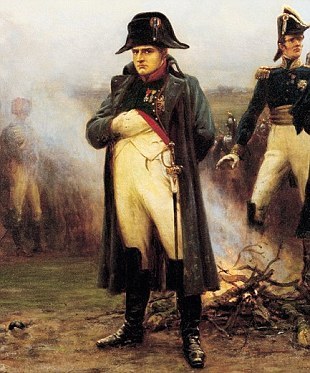

Maschera mortuaria
Le maschere mortuarie erano un antico sistema per creare il calco esatto del viso di un personaggio importante al momento della morte. Prima dell'invenzione della fotografia, si trattava di uno dei modi più efficaci per riprodurre con oggettività le fattezze di una persona: il pennello di un pittore poteva rivelarsi meno affidabile. Durante il regno napoleonico, la Francia sviluppò una forte tradizione di questi oggetti funebri. Così, quando il 5 maggio 1821 l'imperatore morì, gli venne realizzata una maschera mortuaria. A prendere l'impronta il 7 maggio fu Francis Burton, il medico della guarnigione inglese a Sant'Elena, che aveva trovato del gesso sull'isola. Burton fu assistito da Francesco Antonmarchi, anatomista, medico personale di Napoleone, e dalla moglie del maresciallo e amico Bertrand, che presero l'impronta della parte centrale del viso (occhi, naso e bocca). La maschera originale è andata sicuramente persa, ma servì per plasmare copie successive che furono realizzate a Sant'Elena e in tutta Europa. Ed era solo l'inizio. In tutto il mondo esistono moltissime riproduzioni del volto di Napoleone sul letto di morte: una delle ultime è stata ritrovata a Napoli nel 2014.
The death masks were an ancient system to create the exact cast of an important character's face at the time of death. Before the invention of photography, it was one of the most effective ways to objectively reproduce a person's features: a painter's brush could prove less reliable. During the Napoleonic reign, France developed a strong tradition of these funeral objects. Thus, when the emperor died on 5 May 1821, a death mask was created. The impression was taken on 7 May by Francis Burton, the doctor of the English garrison at Saint Helena, who had found some chalk on the island. Burton was assisted by Francesco Antonmarchi, anatomist, Napoleon's personal physician, and by the wife of Marshal and friend Bertrand, who took the imprint of the central part of the face (eyes, nose and mouth). The original mask was definitely lost, but it served to shape successive copies that were made on Sant'Elena and throughout Europe. And it was only the beginning. Worldwide there are many reproductions of Napoleon's face on his deathbed: one of the last was found in Naples in 2014.
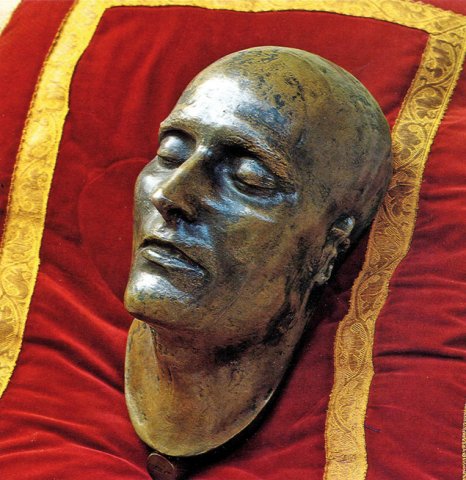

Materasso di Napoleone
A Dego, in Valbormida, c’è il “materasso di Napoleone”, un enorme roccia su cui si dice che Napoleone abbia riposato durante la campagna del 1796.
In Dego, in Valbormida, there is the “mattress of Napoleon”, a huge rock on which Napoleoni s said to have rested during the 1796 campaign.
